Dayens Menuetto Integrated and Grande Mini Loudspeakers
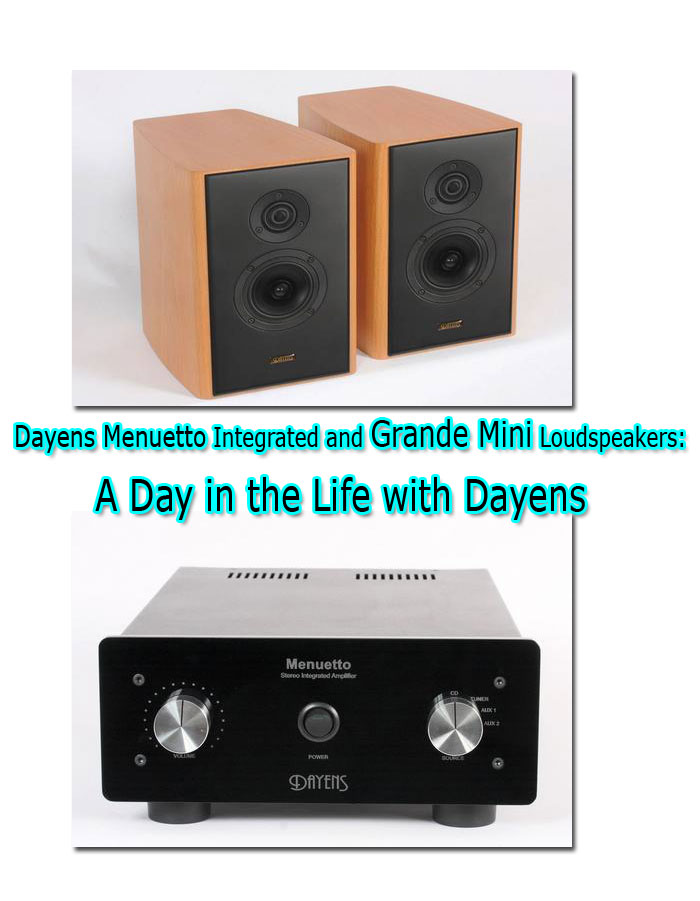
 Serbian-based audio company Dayens made its good name several years back with its benchmark for affordable amplification, the elegantly minimalist, ‘adequately’ powered 30-watt Ampino integrated amplifier. I still own and frequently enjoy the power amp version of this glossy Lilliputian; simply an Ampino integrated minus the ‘blue velvet’ attenuator. Same great sound and reliability and, with a great preamp of course, a bit more detailed.
Serbian-based audio company Dayens made its good name several years back with its benchmark for affordable amplification, the elegantly minimalist, ‘adequately’ powered 30-watt Ampino integrated amplifier. I still own and frequently enjoy the power amp version of this glossy Lilliputian; simply an Ampino integrated minus the ‘blue velvet’ attenuator. Same great sound and reliability and, with a great preamp of course, a bit more detailed.
In the Ampino we have, for the low low price of 58,793.90 Serbian dinars (relax- it’s only like 600 bucks), an amplifier powerful enough to drive most real world speakers in medium-sized real-world living rooms to suitable levels in a decidedly very musically consonant fashion. The Ampinois also very reliable due to its highly functional layout which utilizes top quality parts (like probably five in total;) optimized by ear to work together smartly.
I found the Ampino sound to be refined without being pipe and slippers, and detailed without being etched. There’s just a bit of warmth in the sound but is not overly syrupy. In opting for the power amplifier version of the Ampino (i.e. the identical stereo amp without the Alps potentiometer), one realizes comparatively that some percentage of the detail reduction and warmth characteristic of the integrated may be due to the Alps pot in the circuit, as the stereo amp sounded to my ears a smidge more lit up and detailed than the integrated did.
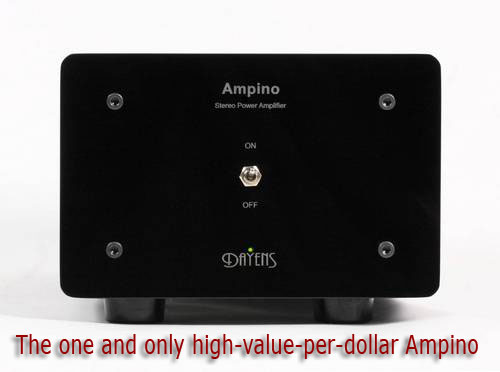
I actually waffled a bit when switching between them — at times preferring the slightly warmer more inviting sound of the integrated version, and at times reveling in the slightly notched up clarity of the stereo amplifier sans potentiometer as paired with the Burson Soloist or Conductor as preamp. I ultimately settled upon the combination of Burson pre/DAC and Dayens stereo power amp, wired them up with Skywire all around, and lived happily with them as the beating heart of my system for the better part of year.
That is until Naim nostalgia (it’s a real thing) caused me to source a Naim Nait XS (circa 2009 version) from Audiogon. See, Naim threatened my family if I didn’t rejoin the fold (there is no easy exit) so I figured I’d just better come crawling back. I’m glad I did. While the XS certainly didn’t ‘destroy’ the Ampino/Burson combo, I do feel it brought a nit of Naim-ness back to the party – notching up the midbass punch somewhat, expanding the soundstage, and quickening the musical pace (yes—rhythm and timing came along as well). J
Honestly though, I’ve gone back a time or two to the Burson/Ampino combo and not felt too emotionally shortchanged. In part, that’s likely because my speakers are generally efficient, I don’t listen too loudly, and the Ampino is an amp that gets essentials right—great midrange, good detail and good pace. Like the Nam, its also leave-it-on-all-the-time reliable.
Pronouncement: (hear ye hear ye and all that) – it is indeed the superb bargain the press says that it is. So yes—I agree with myself (and I don’t often trust reviewers – so that’s saying something). Okay then, but what of their efforts to up the ante? No—we’re not talking an Ampino SE mk. 4 or some such thing (should we be?! Maybe that’s a cool idea!). No. We are talking about… the Dayens Menuetto.
Dayens’d and Confused
According to Mr. Zoran Dobrins, a.k.a Father of The Ampino, as compared with the Ampino, the Menuetto integrated features more (and bigger) of many things, including “more power (50W@8Ohm/70W@4Ohm), more inputs (4 vs. 2 stereo RCA inputs RCA), bigger PSU (200VA toroidal transformer vs 100VA, 2x15000uF audio grade German (Mundorf) electrolytic capacitors vs. 2x10000uF in integrated Ampino), remote volume control utilizing motorized version of ALPS RK27 potentiometer aka Blue Velvet controlled by separate board and different PCB layout than Ampino.”
It is well to note here that the Menuetto’s ‘more’ and ‘bigger’ does not necessarily include ‘better;’ same dual mono construction; same Mundorfs; same Blue Velvet pot etc. etc. This is presumably because Zoran feels the parts quality is so well chosen for its intended purpose, he can just concentrate on scaling the power up or down as befits his particular design goal. Via email, Zoran adds that the Menuetto, Ampino integrated and Ampino stereo power amp are all class A/B amplifiers with one pair of Japanese bipolar output transistors per channel, whereas the Ampino monos and Ecstasy III have two pairs of output transistors per channel.
As to why he prefers Bipolar output transistors (sometimes assumed to be the superior choice for higher current applications) to Mosfets, Zoran offered me a highly technical explanation. He said “we find bipolar transistors to sound more neutral and natural than Mosfets. Or to put more simply: we like their sound.” Go ahead — do your best Clint Eastwood squint and ‘make his day’ — argue.
Out of the box, the Menuetto is heavier than you might expect. Zoran is apparently a believer in overdoing (or correctly implementing) big-ass transformers and the Menuetto is a solid brick — compact and leaden. The feel of the volume pot, a very high quality Alps Blue Velvet, is silky and firm and the power switch doesn’t require a treasure hunt to find and leaves no doubt as to whether the amplifier is engaged or disengaged. I confess I did not use the supplied remote control. I suppose my Burson’s have got me too used to just getting up and turning a knob. In the case of the Menuetto it is thankfully not a stepped knob; just a smooth, silky knob. Honestly though, unless I’m album surfing on Tidal or Spotify, I generally try and find the magical volume setting for a given album and leave it there.
While I did try Naim’s trusty (and elderly) one-size-fits-all-as-long-as-it’s-at-least-3.5-meters-in-length NACA 5 speaker wire with the Menuetto, I preferred my trusty (and middle-aged) Skywire Audio speaker cables and interconnects. The soundstage opened up a bit in all directions with the latter, and the proceedings gained a bit in midrange presence and bass depth.
So now that we’re wired up — what’s the sound of one Menuetto amplifying the sound of one hand clapping? Well, whether it was via my Omega Super 3 XRS single-driver speakers or via Dayens’ own accompanying and paradoxically named Grande Minis, or via the still-shrouded-in-technological-mystery-and-myth Tekton Lore References I am attempting to demystify, the sound was, unsurprisingly, just like an Ampino on the self-same illicit substances that tarnished the reputation of many a major league baseball ‘hero’ [hint: steroids].
Here we indeed have more; more bass and a ‘bigger’ stage with more midbass punch alloyed (and allied) to the same in-the-room mids that won the Ampino so many awards and comment-section cheers. Actually—if you prefer (and maybe I do), you can think of the Dayens Menuetto as the solid-state version of Audio Note’s lower end integrateds. (Haven’t heard the higher end ones).
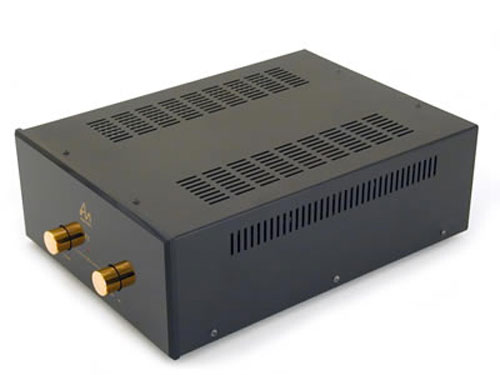
I used to own the wonderful Audio Note P2 SE; an 18 watt push pull 5881 tube integrated and during my time with the Menuetto, I came to feel that if you took the P2SE and added some bass weight and a bit more detail – not to mention the handy ability to drive real-world speakers (as well as solid-state reliability), you come up with the DayensMenuetto. They even kinda look alike!! Conspiracy or what!!?? You tell me!!
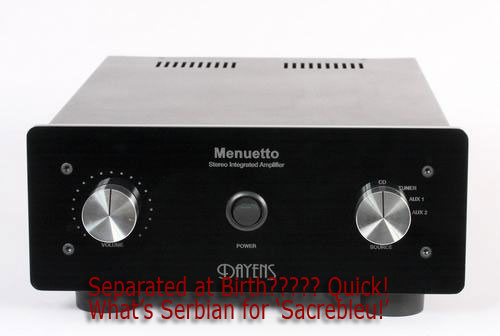
‘Say my name say my Naim…’
The first thing you expect to lose when you go from a Naim to anything else is PRaT – Pace Rhythm and Timing. No. I don’t care if you believe in it. Not interested. I’ve similarly become less interested over the years whether PRaT is in fact a pleasing artificial additive byproduct of particular amplifier topologies or metallurgies, or whether such topologies and/or metallurgies simply excel at allowing more PRaT to shine through when present on the original recording. All I know is — I like it and when it ain’t there, music that I know to be interesting on certain systems becomes by small degree less interesting.
 Hand on heart, substituting the Menuetto for my Nait XS did not make me clutch my pearls. Zoran Dobrin had not taken my PRaT away. Like the Ampino before it and like the Nait XS after that — and like whatever PRaT hound amplifier I’ll discover in the coming years, the Dayens could play Vampire Weekend’s super cool song ‘Step’ from Modern Vampires of the City [XL Recordings] with pretty much the same toe-tapping upbeat/downbeat metronomical verve. Similarly, the end of my favorite Beethoven piano concerto, (No. 5), as played by Lief Ove Andsnes on The Beethoven Journey [Sony Classical] sparkled and bounced to a rollicking close just as it does via my Burson gear paired with the Ampino.
Hand on heart, substituting the Menuetto for my Nait XS did not make me clutch my pearls. Zoran Dobrin had not taken my PRaT away. Like the Ampino before it and like the Nait XS after that — and like whatever PRaT hound amplifier I’ll discover in the coming years, the Dayens could play Vampire Weekend’s super cool song ‘Step’ from Modern Vampires of the City [XL Recordings] with pretty much the same toe-tapping upbeat/downbeat metronomical verve. Similarly, the end of my favorite Beethoven piano concerto, (No. 5), as played by Lief Ove Andsnes on The Beethoven Journey [Sony Classical] sparkled and bounced to a rollicking close just as it does via my Burson gear paired with the Ampino.
The Nait XS head to head had a slight edge in PRaT, but nothing to write to Salisbury (that’s Naim home) about. In my initial listening sessions, then came Susie Suh’s eponymous album [Epic] followed by Eva Cassidy with the musical perfection that is her rendition of ‘People Get Ready’ from Live at Blues Alley [Blix Street] and hellooooooo midrange!
Here’s where the Menuetto really put me in mind of some midrange champions I’ve heard, such as aforementioned Audio Note P2SE and most notably, my long departed and STILL lamented Unison Research Unico (original and un-F’d-with versionJ). There’s a certain sultriness – wet vocals- the in-the-room feel these amps could make happen with their respective proper speaker mates — and the Dayens got there as well. Kind of thing that makes you go ‘yeah — that’s why I keep chasing my tail in this hobby — this is what people need to hear!’ If you read webzines like ours, you know exactly what I’m getting at.
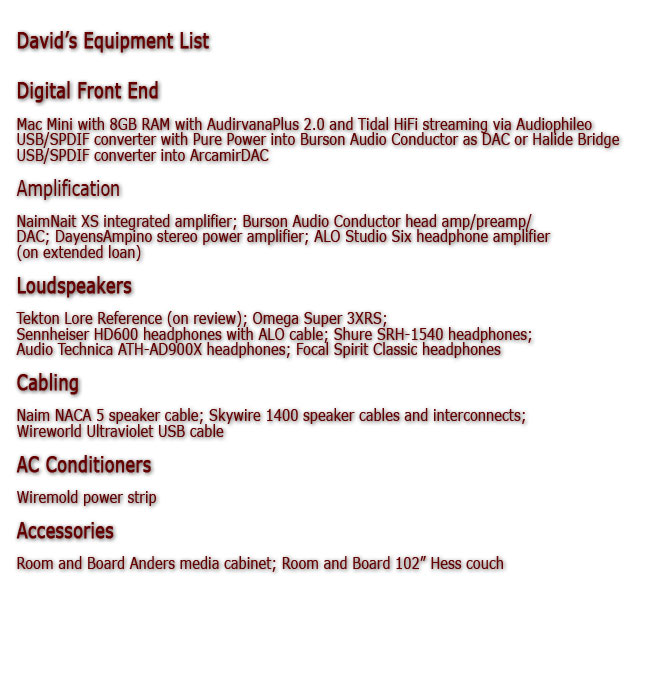 The Menuetto did not have quite the treble detail the XS manages, as evidenced by recordings such as Alexander Markov’s Paganini Concertos No. 1 and 2 [Elektra/Wea] nor perhaps quite as much stage width, though I’d say it surpassed the Nait XS in terms of reproduction of stage depth.
The Menuetto did not have quite the treble detail the XS manages, as evidenced by recordings such as Alexander Markov’s Paganini Concertos No. 1 and 2 [Elektra/Wea] nor perhaps quite as much stage width, though I’d say it surpassed the Nait XS in terms of reproduction of stage depth.
As for ‘mid-bass weight’- and I’m really using the term here to mean a general lack of any perceived thinness to the mid through upper bass/lower midrange range as compared with some more detailed though perhaps ‘sterile’ sounding equipment I’ve heard that may “rank” highly on certain “Recommended Components” lists (and please feel free to do your own ‘air quotes’ with your fingers for those quotation marks), the Dayens and Naim and for that matter, the Unico and the Burson equipment all have it. There’s a broad-shouldered depth and solidity to the sound of these components with a sonic center around the mid bass to lower midrange that the detail-machines lack. Poor tube designs often present muddiness in its place. I think for me this range is where a lot of that ‘PRaT’ thing takes place; or at least my perception of it. [N.B. to the 1 or 2 objectivists reading this ‘drivel’: I am pretty sure many of the aforementioned amplifiers, including the detail machines, do not deviate too much in any direction from flat on your oscilloscope. Kindly use the Google to refer to Zen master Art Dudley’s brilliant relatively recent Stereophile think-piece on A/B testing for why I don’t care].
Finally, I do think the Menuetto held an overall edge on ‘tone’ as compared with the Nait XS. For example, head to head on well-recorded piano such as Lang Lang’s Mozart CD streamed via Tidal HiFi (Finally!! Lossless streaming! What a concept!), the Dayens just edges my admittedly aging Nait XS on the ‘believability’ factor.
It does so by a dint of the conveyance of a bit broader picture of the hammer on string – a few more overtones perhaps, and a touch more heft. I’m being a bit vague here because these are vague things – and the difference here is small, but depending on whom you are and what type of reproduced musical presentation you value, it may be enough.

The Dayens Grande Mini is… neither.
It is neither grand in scale, nor is it truly mini. It is– a small bookshelf speaker about the size of many small bookshelf speakers, albeit with a midrange driver that’s half the diameter (3”) of the one in many small bookshelf speakers. Dayensdid not provide me with a small bookshelf upon which to place this small bookshelf speaker (I had to furnish- get it?;) – myown), though they did provide me with suitable 24” stands.
I was a bit concerned with the entry-levelness of these stands, as it has been my experience that solid heavy speaker stands can go a long way toward the solidifying the bass and broadening the staging of the speakers that sit atop them, though some platitude I recalled about begging and choosing made me decide on being grateful for what I got.
The Grande Mini’s are attractive ‘boat tailed’ speakers ala Sonus Faber and Wharfedale and lots of other companies who have all perhaps come to similar sonic conclusions about plain old boxes and internal speaker resonances i.e. standing waves. Or maybe they’re just worried about impending ‘super-storms’ and wanna be able to get away by using their giant canoe-shaped speakers as fine hardwood outriggers for their house boat. We are left to wonder…
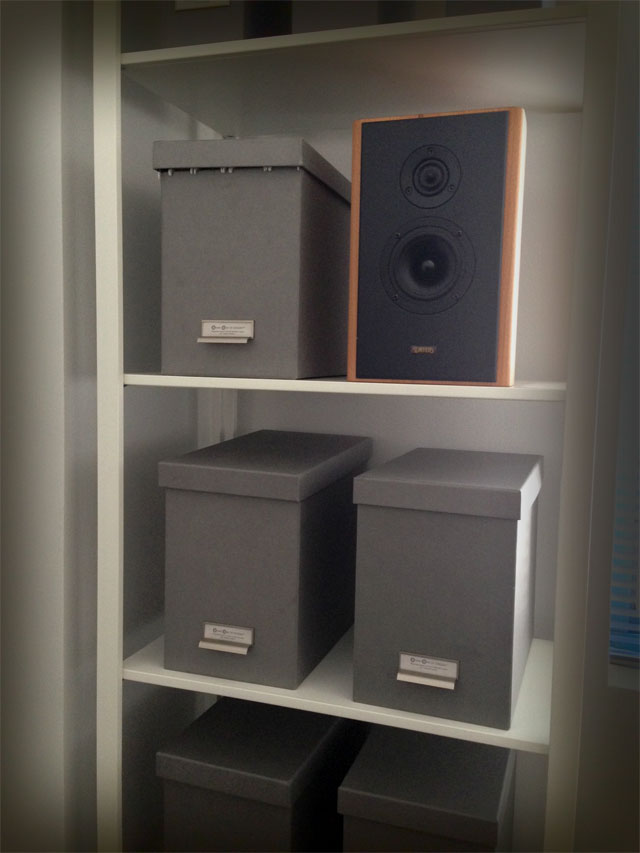
A small bookshelf speaker upon a small bookshelf (fitting, no?)
In any case, the Minis employ a ring radiator; a tweeter technology which I have heard (and liked) previously in Audio Physics loudspeakers (and also in use on the Sonus Faber Venere’s; just saying). As with the ‘boat tail’ cabinet shape, many companies obviously feel the ring radiator tweeter offers certain advantages, such as more desirable dispersion characteristics and resonant frequency advantages over the more de rigueur dome tweeter.
My own view on ring radiator tweeters is the same one I’ve come to hold as regards to nearly every technology I’ve heard implemented in the service of audio reproduction. Namely – it’s not the technology implemented, but how you implement the technology.
(Yes you may quote me. Yes you may place said quote on a substandard t-shirt,sell those t-shirts for an inflated price on Etsy, and provide me with a modest commission derived from sales of said substandard overpriced t-shirts. You’re welcome).
Grand Ol’ Mini
The Mini did not sound ‘grand’ in sense of scale, tempting though it would be to celebrate that notion literarily if it were true. Rather, it sounded like a finely tuned, very coherent bookshelf speaker ideally suited for a smaller room. I typically place speakers of any ilk approximately 7 or 8 feet apart center to center with maybe 15 to 20 degrees of toe in. The Grande Minis were a bit different in that they preferred being a foot or so closer to one another; say 6 feet apart center to center, with maybe 10 or 15 degrees of toe in. They did not seem to need close proximity to the front wall to develop their bass capabilities and in this regard, liked being about where my other speakers like to be in the larger living room; roughly 18 or so inches out into the room.
Set up thusly, I was struck by how similar they were tonally to the Tekton speakers I’m familiar with; both the Reference Lores (under review) and the previously reviewed M-Lores. Possibly by dint of their large rear port in conjunction with the standing wave reducing ‘boat tail’ cabinet design, they managed enough bass weight and heft with a 3” midrange to pass the scientifically rigorous ‘close your eyes and guess the size of the speaker’ test (read: it’s hard to).
While they certainly could not play bass with the authority of even the smaller floor-standing Tekton M-Lore I previously reviewed, the minis were definitely not anemic and carried on with enough bass oomph to cause some doubt you were hearing a small bookshelf speaker blindfolded. That bass was also relatively taught and tuneful. The designer did not seem to opt for mid-bass bloat in order to attempt an abstract ‘impression’ of a larger speaker.
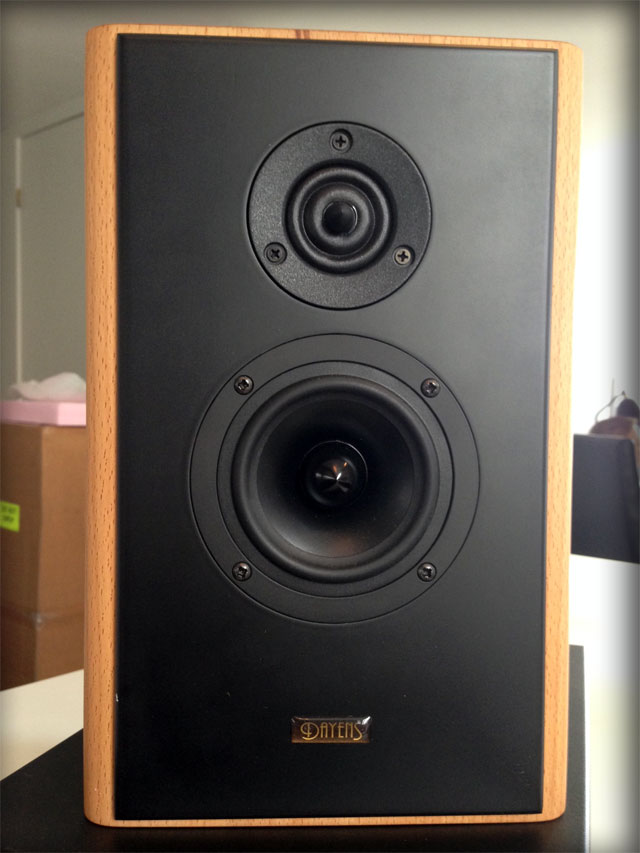
You’re a Grand Ol’ Mini, you’re a high flyin’ Mini…
Their admittedly smaller (than the Tektons) soundstage was definitely of the ‘where’d the speakers go?’ variety, but I’d be more shocked if a coherent small two-way bookshelf with a ring radiator and a 3” midrange driver couldn’t pull off such a disappearing act.
Where speakers with small drivers, like my Omega Super 3XRS, really shine is in the midrange. Some say this has a lot to do with a 5 or 6” midrange driver being about the same size physically as the sound emanating from the bell of a trumpet or the mouth of a singer. It does seem that smaller diameter drivers do special things with voices and solo instruments and I suppose they better in order to offset their obvious limitations in loudness and bass.
The Grande Mini was certainly no exception and solo singers such as Ella and Louis (heard of them?) on… wait for it… Ella and Louis [Polygram Records] sounded very plausible and present. In fact, I’d put the overall tonality and presence of smaller musical ensembles and voices right there with the Tektons, and that’s’ saying something, because the Tekton sound is warm, inviting and in-the-room present.
At my usual listening levels (read: incredibly overpriced New York apartment approved), there was not the big reduction in dynamics I was worried about when switching off from the Lores to the Minis. There was however certainly the expected reduction in scale and some decrease in the amount of ‘air’ moving around the players which has the effect of reducing the overall impact of a dynamic swing or larger ensemble piece. Yes, the smaller scale speaker did play somewhat smaller in scale. Sooo… no shocker there either.

Partners in harmony
The tweeter/mid blend was about as seamless as I’ve heard and the treble certainly impressed me as defined and refined. I was not aware of any excess sibilance or whittling away of fine detail as compared with the big Tektons.
My Omega Supers presented a very good foil from the standpoint of sonic comparison, as they are in a similar price range and more importantly, employ an(almost) similarly sized driver. Differences? Yeah- they only have a single driver to the Mini’s two. They also presented music differently. While both speakers loved the Menuetto amp, the Omegas are a bit more forward sounding across the frequency range. In this regard, the overall presentation of the Dayens speaker is more in line with the Tekton presentation than the Omegas. Generally speaking, bass is more rock solid and defined with the Omegas, and via the Dayens it is a touch softer and more rounded. For that matter, so is the midrange. There is more treble detail on offer with the Dayens Mini despite it’s overall more laid back character. Jumping to the Dayens immediately from the ultra coherent (one driver!) Omegas proved complimentary to the Grande Minis in that they did not sound ‘much less coherent’ or any such thing. The immediate impression was more of a ‘step back’ in the soundstage presentation and ‘rounder’ mids and bass with a bit more treble detail. Sadly, I did not have an actual tube amp on hand to compare the two speakers on, as that would have proved instructive.
Summing up, I don’t think the Dayens Grande Mini would do well as your primary home theater speaker (unless you live in a 600 square foot studio apartment in Greenwich Village?). Rather it is perfectly at home in a smaller room (ohhh about say, 13×15 or 14×16 feet) with say, an Ampino integrated or a Menuetto lashed to it and fed a steady genre of anything but Death Metal or heavy EDM. It is a refined, coherent speaker with a slightly relaxed tonal quality and excellent treble detail that, appropriately set up, does not sound ‘Mini.’ Used on sturdier stands, I may have gotten even more out of them in terms of bass and staging than I did and that’d certainly be my recommendation when auditioning a pair yourself.
Dayens, Day out
It seems once again that Dayens has proved itself a brand I would be seen with in an upscale nightclub. Along with Burson, Naim, Unison Research and Audio Note, their amplifiers present music in a balanced and engaging manner and seem to do so for what are very reasonable prices.
More over, the Dayens amplifiers (now two in my experience) have proven themselves reliable, very quiet in terms of electrical noise, and versatile in terms of preferred speaker pairings. I really wish there were a less clichéd way to convey to you that I really recommend you shortlist the DayensMenuetto in its respective price range when auditioning amplification; especially if you particularly value tonal beauty but don’t want to put up with some of the added… errr… lets call it fun of owning a tube amplifier.
The Grande Mini’s are perfectly positioned for what they are; a very coherent slightly relaxed sounding small bookshelf with amply extended bass for their size and an airy open, detailed treble, that work exceedingly well when space is at a relative premium. Alternatively, in a larger space, I imagine one of the more modern subs like a Rel with auto equalization etc. could make the sleek looking Grade Mini into a the basis for a very coherent and musical sub/sat pairing. I look forward to hearing more offerings from this well-rounded company in the near future. Until then…
I bid you peace.


Component Specifications:
Menuetto integrated amplifier
Retail Price: 1200.00 US dollars
Power (Watts): 2x50W/8 Ohms (2x70W/4 Ohms)
Inputs: 4
Frequency Response: 1Hz – 200KHz
SNR (db): >92
Dimensions (mm): 9 x 14 x 4.5 (inches)
Weight (Kg): 14.5lbs
Grande Mini loudspeakers
Retail Price: 1800.00 US dollars
Type: Two-way
Enclosure type: Bass reflex (back port)
Impedance: 8 Ohms
Sensitivity: 87 dB
Frequency range: 55-40000Hz
Recommended amplifier power: 25-100 Watts
Connection output: Single wire
Dimensions (HxWxD): 11.5 x 7.1 x 9.5 (inches)
Weight: 22 lbs (pair)
Website: www.dayens.rs/eng_about.html
One thought on "Dayens Menuetto Integrated and Grande Mini Loudspeakers"
Leave a Reply
Stereo Times Masthead
Publisher/Founder
Clement Perry
Editor
Dave Thomas
Senior Editors
Frank Alles, Mike Girardi, Russell Lichter, Terry London, Moreno Mitchell, Paul Szabady, Bill Wells, Mike Wright, and Stephen Yan,
Current Contributors
David Abramson, Tim Barrall, Dave Allison, Ron Cook, Lewis Dardick, John Hoffman, Dan Secula, Don Shaulis, Greg Simmons, Eric Teh, Greg Voth, Richard Willie, Ed Van Winkle, Rob Dockery, Richard Doron, and Daveed Turek
Site Management Clement Perry
Ad Designer: Martin Perry






Hello Mr. Abramson,
I very much enjoyed your review on the Dayens Integrated Amplifiers. My needs for a (in this case) a Solid State Amp is simple/basic (NO frills, purist if you will). As such, I have been considering the “Menuetto” Amp. I recently acquired a pair of English made (TOTL circa late 1980’s) Mission (two way) 4 Ohm “Argonaut” Classic Speakers (94.5 sensitive) which I very much enjoy listening. I mostly listen to Classic Jazz (NO streaming/using a CD Player). I do not listen loudly due to hearing issue (Tinnitus). This being said, might you have any experience with the French Company ATOLL ? Aside from the “Menuetto” I am also quite interested in ATOLL’s (entry level) IN50 Integrated Amp. Since I live in Maine, I’m going to have to gamble as to which Amp might sound best with my “Argonaut” Speakers. I very much enjoy my Tube gear (both Stereo and Mono systems). I especially enjoy listening to my FISHER 400 with my vintage EMI DLS 529 Speakers. I tried the FISHER 400 Tube Receiver with the “Argonauts” however, while it sounded nice, the “Argonauts” (to my Ears) sound MUCH more alive/exciting when using a Solid State Amp. Surprisingly, the “Argonauts” sounded VERY good (better Bass/weight/fullness) using an old NAD 3140 Integrated Amp (which is now defunct). I have found the OLD NAD Amps to sound better overall than the newer units (such as the BEE series). At any rate, any suggestions/thoughts you may offer regarding Atoll or Dayens would be most appreciated.
Regards,
Tom Patrick in Maine